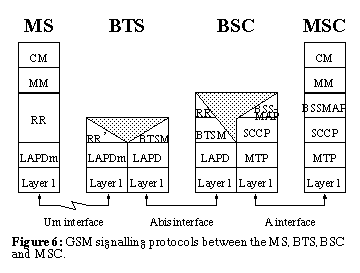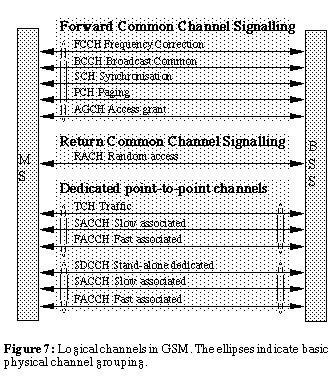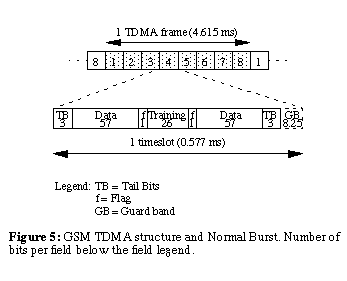
This page is not an introduction to the basics of cellular telephony. (That article covers a number of standards popular in the United States, as well as describing cells and frequency reuse.)
A detailed description of the GSM system can be found in [MOU92] and in [BJU95], in addition to the GSM recommendations. An index to GSM information is available. This Overview Of The GSM System and Protocol Architecture is worth reading, as is another overview.
The following sections will briefly describe the functional entities, the radio interface signalling protocol, the logical and physical channel structure and the TDMA structure based on GSM.
Some GSM system parameters are listed in the table below. Wikipedia gives a summary of GSM frequency use.
| Multiple Access Method | TDMA / FDMA |
|---|---|
| base station to mobile frequencies (MHz) | 935-960 (basic GSM) |
| mobile to base station frequencies (MHz) | 890-915 (basic GSM) |
| Duplexing | FDD |
| Channel spacing, kHz | 200 |
| Modulation | GMSK |
| Portable TX power, maximum / average (mW) | 1000 / 125 |
| Power control, handset and BSS | Yes |
| Speech coding and rate (kbps) | RPE-LTP / 13 |
| Speech Channels per RF channel: | 8 |
| Channel rate (kbps) | 270.833 |
| Channel coding | Rate 1/2 convolutional |
| Frame duration (ms) | 4.615 |

| MS | Mobile Station. The MS is the physical equipment used by a subscriber,
most often a normal hand-held cellular telephone. |
|---|---|
| BTS | Base Transceiver Station. The BTS comprises the radio transmission
and reception devices, and also manages the signal processing related to
the air interface. |
| TRAU | The Transcoder Rate Adaptor Unit. The TRAU (not shown in the above
figure) functionally belongs to the BTS. The TRAU enables the use of lower
rates (32, 16 or 8 kbps) over the A-bis interface instead of the 64 kbps
ISDN rate for which the MSC is designed. The TRAU can be located at the
BTS, the BSC, or (immediately in front of) the MSC. |
| BSC | Base Station Controller. The BSC manages the radio interface, mainly
through the allocation, release and handover of radio channels. |
| BSS | Base Station System. The BSS consists of a BSC and one or more BTSs. |
| MSC | Mobile Switching Centre. The MSC is basically an ISDN-switch, coordinating
and setting up calls to and from MSs. An Inter-Working Function (IWF) may
be required to adapt GSM specific rates to that used in a particular PSTN/
PLMN. |
| VLR | Visitor Location Register. The VLR contains all the subscriber data,
both permanent and temporary, which are necessary to control a MS in the
MSCs coverage area. The VLR is commonly realised as an integral part of
the MSC, rather than a separate entity. |
| AuC | Authentication Centre. The AuC database contains the subscriber authentication
keys and the algorithm required to calculate the authentication parameters
to be transferred to the HLR. |
| HLR | Home Location Register. The HLR database is used to store permanent
and semi-permanent subscriber data; as such, the HLR will always know in
which location area the MS is (assuming the MS is in a coverage area),
and this data is used to locate an MS in the event of a MS terminating
call set-up. |
| EIR | Equipment Identity Register. The EIR database contains information
on the MS and its capabilities. The IMEI (International Mobile Subscriber
Identity) is used to interrogate the EIR. |
| GMSC | Gateway Mobile Switching Centre. The GMSC is the point to which a MS
terminating call is initially routed, without any knowledge of the MS's
location. The GMSC is thus in charge of obtaining the MSRN (Mobile Station
Roaming Number) from the HLR based on the MSISDN (Mobile Station ISDN number,
the "directory number" of a MS) and routing the call to the correct
visited MSC. The "MSC" part of the term GMSC is misleading, since
the gateway operation does not require any linking to a MSC. |
| SMS-G |
This is the term used by [MOU92] to collectively
describe the two Short Message Services Gateways described in the GSM recommendations.
The SMS-GMSC (Short Message Service Gateway Mobile Switching Centre) is
for mobile terminating short messages, and SMS-IWMSC (Short Message Service
Inter-Working Mobile Switching Centre) for mobile originating short messages.
The SMS-GMSC role is similar to that of the GMSC, whereas the SMS-IWMSC
provides a fixed access point to the Short Message Service Centre. |
| Um | The air interface is used for exchanges between a MS and a BSS. LAPDm,
a modified version of the ISDN LAPD, is used for signalling. |
|---|---|
| Abis | This is a BSS internal interface linking the BSC and a BTS, and it
has not been standardised. The Abis interface allows control of the radio
equipment and radio frequency allocation in the BTS. |
| A | The A interface is between the BSS and the MSC. The A interface manages
the allocation of suitable radio resources to the MSs and mobility management. |
| B | The B interface between the MSC and the VLR uses the MAP/B protocol.
Most MSCs are associated with a VLR, making the B interface "internal".
Whenever the MSC needs access to data regarding a MS located in its area,
it interrogates the VLR using the MAP/B protocol over the B interface.
|
| C | The C interface is between the HLR and a GMSC or a SMS-G. Each call
originating outside of GSM (i.e., a MS terminating call from the PSTN)
has to go through a Gateway to obtain the routing information required
to complete the call, and the MAP/C protocol over the C interface is used
for this purpose. Also, the MSC may optionally forward billing information
to the HLR after call clearing. |
| D | The D interface is between the VLR and HLR, and uses the MAP/D protocol
to exchange the data related to the location of the MS and to the management
of the subscriber. |
| E | The E interface interconnects two MSCs. The E interface
exchanges data related to handover between the anchor and relay MSCs using
the MAP/E protocol. |
| F | The F interface connects the MSC to the EIR, and uses the MAP/F protocol
to verify the status of the IMEI that the MSC has retrieved from the MS. |
| G | The G interface interconnects two VLRs of different MSCs and uses the
MAP/G protocol to transfer subscriber information, during e.g. a location
update procedure. |
| H | The H interface is between the MSC and the SMS-G, and uses the MAP/H
protocol to support the transfer of short messages. |
| I | The I interface (not shown in Figure 1) is the interface
between the MSC and the MS. Messages exchanged over the I interface are
relayed transparently through the BSS. |

| CM | The Communication Management (CM) layer consists of setting up calls
at the users' request. Its functions are divided in three: Call control,
which manages the circuit oriented services; Supplementary services management,
which allows modifications and checking of the supplementary services configuration;
Short Message Services, which provides point-to-point short message services.
|
|---|---|
| MM | The Mobility Management (MM) layer is in charge of maintaining the
location data, in addition to the authentication and ciphering procedures. |
| RR | The Radio Resource (RR) Management layer is in charge of establishing
and maintaining a stable uninterrupted communications path between the
MSC and MS over which signalling and user data can be conveyed. Handovers
are part of the RR layers responsibility. Most of the functions are controlled
by the BSC, BTS, and MS, though some are performed by the MSC (in particular
for inter-MSC handovers.). |
| RR' | The RR' layer is the part of the RR functionality which is managed
by the BTS. |
| LAPDm | The layer two protocol is provided for by LAPDm over the air-interface.
This protocol is a modified version of the LAPD (Link Access Protocol for
the ISDN D-channel) protocol. The main modifications are due to the tight
synchronisation required in TDMA and bit error protection mechanism required
over the air-interface (and in GSM handled by layer 1), making the corresponding
functionality of the LAPD protocol redundant (and thus wasteful over the
air-interface). The LAPD frame flags are replaced by a length indicator,
and the FEC field is removed. |
| BTSM | The Base Transceiver Station Management (BTSM) is responsible for transferring
the RR information (not provided for in the BTS by the RR' protocol) to
the BSC. |
| LAPD | This is the ISDN LAPD protocol (Link Access Protocol for the ISDN D-channel)
providing error-free transmission between the BSC and MSC. |
| BSSAP | The Base Station System Application Part (BSSAP) is split into two
parts, the BSSMAP and the DTAP (not shown in the above figure). The message
exchanges are handled by SS7. Messages which are not transparent to the
BSC are carried by the Base Station System Management Application Part
(BSSMAP), which supports all of the procedures between the MSC and the
BSS that require interpretation and processing of information related to
single calls, and resource management. The messages between the MSC and
MS which are transparent to the BSC (MM and CM messages) are catered for
by the Direct Transfer Application Part (DTAP). |
| SCCP | The Signalling Connection Control Part (SCCP) from SS7. |
| MTP | The Message Transport Part (MTP) of SS7. |

These logical channels are defined in GSM:
| TCHf | Full rate traffic channel. |
|---|---|
| TCH h | Half rate traffic channel. |
| BCCH | Broadcast Network information, e.g. for describing the current control
channel structure. The BCCH is a point-to-multipoint channel (BSS-to-MS). |
| SCH | Synchronisation of the MSs. |
| FCH | MS frequency correction. |
| AGCH | Acknowledge channel requests from MS and allocate a SDCCH. |
| PCH | MS terminating call announcement. |
| RACH | MS access requests, response to call announcement, location update,
etc. |
| FACCHt | For time critical signalling over the TCH (e.g. for handover signalling).
Traffic burst is stolen for a full signalling burst. |
| SACCHt | TCH in-band signalling, e.g. for link monitoring. |
| SDCCH | For signalling exchanges, e.g. during call setup, registration / location
updates. |
| FACCHs | FACCH for the SDCCH. The SDCCH burst is stolen for a full signalling
burst. Function not clear in the present version of GSM (could be used
for e.g. handover of an eight-rate channel, i.e. using a "SDCCH-like"
channel for other purposes than signalling). |
| SACCHs | SDCCH in-band signalling, e.g. for link monitoring |
